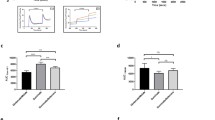Summary
Trifluoperazine (TFP) (35 μM) prevents mitochondrial transmembrane potential (δϕ) collapse and swelling induced by 10μM Ca2+ plus oxyradicals generated from σ-aminolevulinic acid autoxidation. In contrast with EGTA, TFP cannot restore the totally collapsed δΦ. So, TFP might not remove Ca2+ from its ‘harmful site’, but could impair the ROS-driven cross-linking between membrane-SH proteins. Our data are correlated with the protective uses of TFP against oxidative processes promoted by oxyradicals plus Ca2+.
Similar content being viewed by others
Abbreviations
- EGTA:
-
ethyleneglycol bis (β-amino-ethyl ether) N, N′-tetraacetic acid
- TPP+ :
-
tetraphenylphosphonium
- HEPES:
-
4-(2-hydroxyethyl)-1-piperazineethanesulfonic acid
- RLM:
-
rat liver mitochondria
- δΦ:
-
transmembrane electrical potential
References
Pereira R.S., Bertocchi A.P.F., Vercesi A.E. (1992): Protective effect of trifluoperazine on the mitochondrial damage induced by Ca2+ plus prooxidants. Biochem. Pharmacol., 44, 1795–1801.
Orrenius S, McConkey D.J., Bellomo G., Nicotera P. (1989): Role of Ca2+ in toxic cell killing. Trans. Pharmacol. Sci., 10, 281–285.
Gunter T.E., Pfeiffer D.R. (1990): Mechanisms by which mitochondria transport calcium. Am. J. Physiol., 258, C755-C786.
Hermes-Lima M., Valle V.G.R., Vercesi A.E., Bechara E.J.H. (1991): Damage to rat liver mitochondria promoted by σ-aminolevulinic acid-generated reactive oxygen species: connections with acute intermittent porphyria and lead-poisoning. Biochim. Biophys. Acta, 1056, 57–63.
Hermes-Lima M., Castilho R.F., Valle V.G.R., Bechara E.J.H., Vercesi A.E. (1992): σ-aminolevulinic acid induces a Ca2+-dependent mitochondrial oxidative stress antagonized by Mg2+: a model for acute intermittent porphyria. Biochim. Biophys. Acta, 1180, 201–206.
Medeiros M.H.G., Mascio P.D., Gründel S., Soboll S., Sies H., Bechara E.J.H. (1994): Catabolism of 5-aminolevulinic acid to CO2 by rat liver mitochondria. Arch. Biochem. Biophys., 310, 205–209.
Valle V.G.R., Fagian M.M., Parentoni L.S., Meinicke A.R.m Vercesi A.E. (1993): The participation of reactive oxygen species and protein thiols in the mechanism of mitochondrial inner membrane permeabilization by calcium plus prooxidants. Arch. Biochem. Biophys., 307, 1–7.
Fagian M.M., Pereira-de-Silva L., Martins I.S., Vercesi A.E. (1990): Membrane protein thiol cross-linking associated with the permeabilization of the inner mitochondrial membrane by Ca2+ plus prooxidants. J. Biol. Chem., 265, 19955–19960.
Kamo N., Muratsugo M., Ruji H., Kobatake J. (1979): Membrane potential of mitochondria measured with an electrode sensitive to tetraphenylphosphonium and relationship between proton electrochemical potential and phosphorylation potential in steady-state. J. Membr. Biol., 48, 105–121.
Muratsugu M., Kamo K., Kurihara K., Kobatake J. (1977): Selective electrode for dibenzyl ammonium cation as indicator of membrane potential in biological systems. Biochim. Biophys. Acta, 464, 613–619.
Jensen B.D., Gunter K.K., Gunter T.E. (1986): The efficiencies of the component steps of oxidative phosphorylation. II. Experimental determination of the efficiencies in mitochondria and examination of the equivalence of membrane potential and pH gradient in phosphorylation. Arch. Biochem. Biophys., 248, 305–323.
Strzelecki T., McGraw B.R., Khauli R.B. (1990): Comparison of the effect of cyclosporine, verapamil and trifluoperazine on calcium-induced membrane permeability of mitochondria. Transplant Proc., 21, 182–183.
Vale M.G.P., Moreno A.J.M., Carvalho A.P. (1983): Effect of calmodulin antagonists on the active Ca2+ uptake by rat liver mitochondria. Biochem. J., 214, 929–935.
Kosower N.S., Kosower E.M. (1978): The glutathione status of cells. Int. Rev. Cytol., 54, 109–160.
Beitner R., Chen-Zion M., Sofer-Bassukevitz Y., Morgenstern H., Ben-Porat H. (1989): Treatment of frostbite with calmodulin antagonists thioridazine and trifluoperazine, Gen. Pharmacol., 20, 641–646.
Manson P.N., Jesudass R., Marzella L., Burkley G.B., Im M.J., Narayan K.K. (1991): Evidence for an early radical-mediated reperfusion injury in frostbite. Free Rad. Biol. Med., 10, 7–11.
Author information
Authors and Affiliations
Rights and permissions
About this article
Cite this article
De Souza Pereira, R., Hermes-Lima, M. Can trifluoperazine protect mitochondria against reactive oxygen species-induced damage?. European Journal of Drug Metabolism and Pharmacokinetics 21, 281–284 (1996). https://doi.org/10.1007/BF03189728
Received:
Issue Date:
DOI: https://doi.org/10.1007/BF03189728




